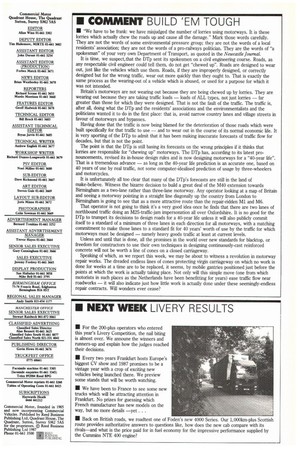• COMMENT BUILD 'EM TOUGH
Page 5

If you've noticed an error in this article please click here to report it so we can fix it.
• "We have to be frank: we have misjudged the number of lorries using motorways. It is these lorries which actually chew the roads up and cause all the damage." Mark those words carefully. They are not the words of some environmental pressure group; they are not the words of a local residents' association; they are not the words of a pro-railways politician. They are the words of "a spokesman" of your very own Department of Transport, as quoted in the Newcastle Journal.
It is time, we suspect,that the DTp sent its spokesmen on a civil engineering course. Roads, as any respectable civil engineer could tell them, do not get "chewed up". Roads are designed to wear out, just like the vehicles which use them. Roads, if they are improperly designed, or correctly designed but for the wrong traffic, wear out more quickly than they ought to. That is exactly the same process as the wearing-out of a vehicle which is abused, or used for a purpose for which it was not intended.
Britain's motorways are not wearing out because they are being chewed up by lorries. They are wearing out because they are taking traffic loads — loads of ALL types, not just lorries — far greater than those for which they were designed. That is not the fault of the traffic. The traffic is, after all, doing what the DTp and the residents' associations and the environmentalists and the politicians wanted it to do in the first place: that is, avoid narrow country lanes and village streets in favour of motorways and bypasses.
Having done that the traffic is now being blamed for the deterioration of those roads which were built specifically for that traffic to use — and to wear out in the course of its normal economic life. It is very sporting of the DTp to admit that it has been making inaccurate forecasts of traffic flow for decades, but that is not the point.
The point is that the DTp is still basing its forecasts on the wrong principles if it thinks that lorries are responsible for "chewing up" motorways. The DTp has, according to its latest pronouncements, revised its in-house design rules and is now designing motorways for a "40-year life". That is a tremendous advance — as long as the 40-year life prediction is an accurate one, based on 40 years of use by real traffic, not some computer-idealised prediction of usage by three-wheelers and motorcycles.
It is unfortunately all too clear that many of the DTp's forecasts are still in the land of make-believe. Witness the bizarre decision to build a great deal of the M40 extension towards Birmingham as a two-lane rather than three-lane motorway. Any operator looking at a map of Britain and seeing a motorway pointing in a straight line diagonally up the country from London to Birmingham is going to see that as a more attractive route than the repair-ridden MI and M6.
That operator is not going to think it's a very good idea once he finds that there are two lanes of northbound traffic doing an M25-traffic-jam impersonation all over Oxfordshire. It is no good for the DTp to trumpet its decisions to design roads for a 40-year life unless it will also publicly commit itself to a standard of a minimum of three lanes in each direction for all motorways, with a matching commitment to make those lanes to a standard fit for 40 years' worth of use by the traffic for which motorways must be designed — namely heavy goods traffic at least at current levels.
Unless and until that is done, all the promises in the world over new standards for blacktop, or freedom for constructors to use their own techniques in designing continuously-cast reinforced concrete will not be worth a line of cones on a closed carriageway.
Speaking of which, as we report this week, we may be about to witness a revolution in motorway repair works. The dreaded endless lines of cones protecting virgin carriageway on which no work is done for weeks at a time are to be replaced, it seems, by mobile gantries positioned just before the points at which the work is actually taking place. Not only will this simple move (one from which motorists in such places as the Netherlands have been benefitting for years) ease traffic flow near roadworks — it will also indicate just how little work is actually done under these seemingly-endless repair contracts. Will wonders ever cease?




























































































